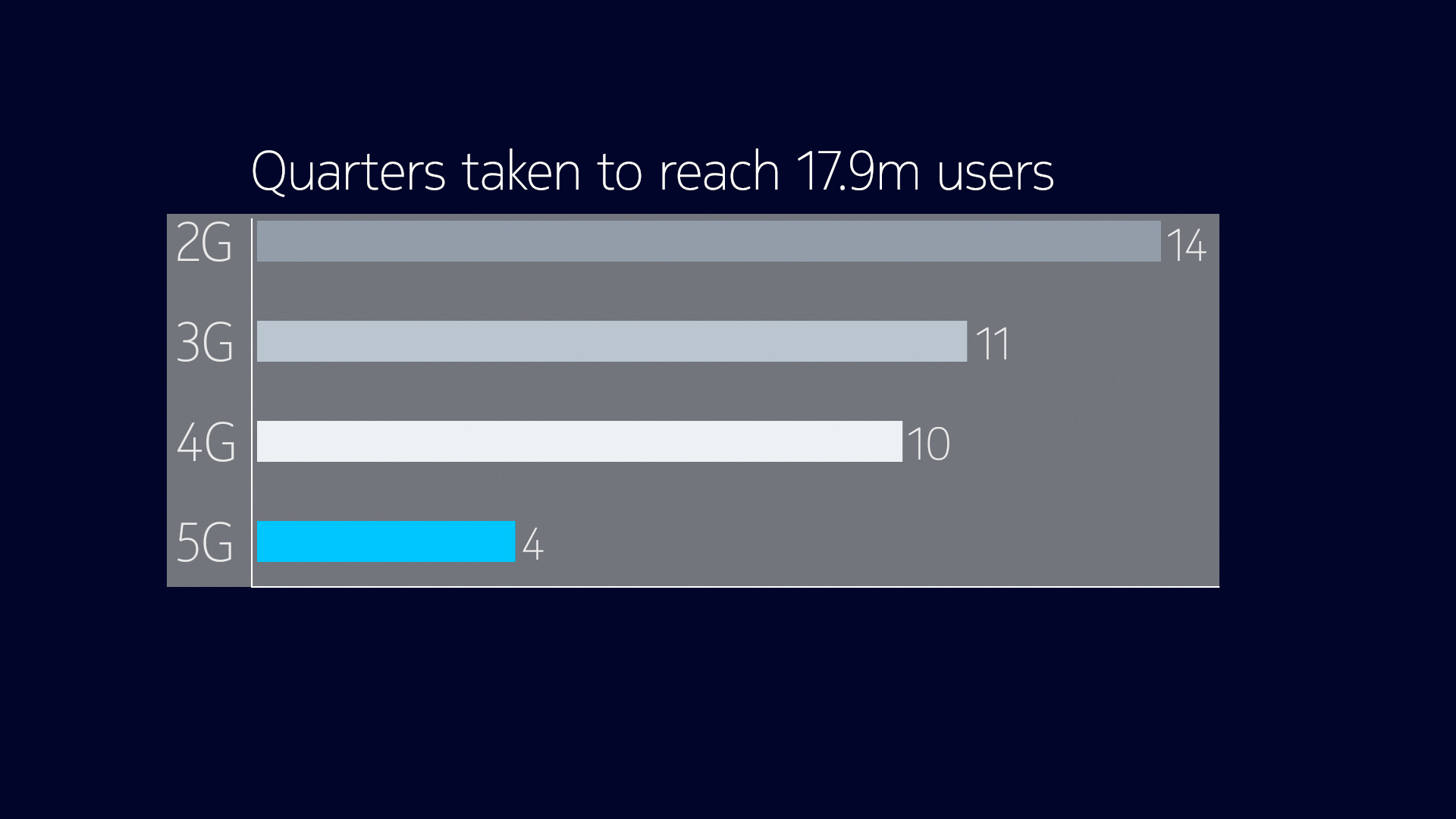Industry 4.0: brought to you by private wireless and 5G
Stephane Daeuble, head of enterprise solutions marketing at Nokia, on why enterprises need to explore how private wireless and 5G can transform their business.

What’s going to be the biggest impact of 5G? The fifth generation of cellular networks is much more than blazing fast mobile broadband. Research by Nokia Bell Labs found that 5G has the potential to contribute $8 trillion to global GDP by 2030, with industries as diverse as mining, entertainment, transportation and healthcare all set to reap enormous benefits.
Asset-heavy industries are already seeing the benefit of cellular networks which enable digitalization and automation to sustainably source resources, move them to market, manufacture, power, operate and service all aspects of our new, technological world.
Moving beyond WiFi
"Following an audit of all wireless applications, it became obvious to him that only a licensed-spectrum solution could provide the assurance that the business needed."
Stephane Daeuble, Nokia.
In the early 2010s, principal for infrastructure and communications strategy, Alan Seery, was at a Rio Tinto mine in Pilbara in north western Australia, mulling why the autonomous trucks had begun to mysteriously stop working. There were multiple communications networks at the site. After extensive investigation, it was discovered that a third-party contractor had commissioned a WiFi link to connect two buildings together, and the interference caused by this link had impacted the network supporting the autonomous trucks, and caused them to stop working. Alan knew there had to be a better way. Following an audit of all wireless applications, it became obvious to him that only a licensed-spectrum solution could provide the assurance that the business needed. And so, the first 4G/LTE private wireless network in the resources industry globally and first private 4G/LTE private wireless in Australia was born.
Characterized by computing and the internet, the third industrial revolution profoundly impacted services businesses such as financial services and the media. But asset-intensive industries with a lot of heavy equipment, production lines and materials handling missed out on this ‘digital revolution’. The WiFi networks that work well in an office setting aren’t designed for mobility, making them inappropriate for asset-heavy industries with operational technology application needs.
But that is set to change with the fourth industrial revolution, or Industry 4.0, which will be powered by mobile networks starting with 4.9G (latest generation 4G/LTE) and migrating to 5G as business needs emerge. Mobile networks are designed to reliably connect devices which are on the move. In difficult radio environments, they have greater capacity, large coverage and better signal penetration. And most importantly, they provide predictable lower latency, which is essential for machine to machine connectivity such as robotics where there can be no delay variation from instruction to reaction.
Moreover, mobile networks are helping industries meet their emissions goals. GSMA, the mobile operator industry body, and the Carbon Trust found that through digitalization and automation, 5G has the potential to decrease emissions in other sectors by 10 times the amount of emissions produced by mobile networks themselves.
Private wireless
Private wireless is a standalone network focused on industrial operational assets and users. A private wireless network provides wireless broadband connectivity, like a public wireless network, but is owned and controlled by the organization that built or purchased it. Industry verticals and public sector domains such as mining, utilities, factories, warehouses, ports, airports, public safety, and smart cities all make excellent candidates for private wireless and are already using such networks to help digitalize their operations.
Get up to speed with 5G, and discover the latest deals, news, and insight!
We predict the potential need for 14 million global industrial sites to be equipped with private wireless connectivity in the coming decade. According to ABI, the private wireless market is expected to grow to USD16.3bn in 2025.
The 5G advantage: ultra-reliable low latency
Ultra-reliable low latency is crucial in use cases such as performing remote heart surgery or for self-driving cars, when losing connection for a couple of seconds is not an option.
When the industry talks about 5G, it is referring to a set of mobile networks specifications produced by the mobile technologies standards body, 3GPP. One such specification is for five nines or even six nines reliability with a latency as low as 1ms. Six nines reliability means 99.9999% of packets will be delivered within one millisecond and is achieved through many technological advances in network design such as baking in near-instantaneous packet failover, software defined (as opposed to hardwire) network routing, dual connectivity and more redundancy.
Latency is the delay in a network between an instruction being given and the action being commenced. Low latency is needed in some of the most advanced industrial applications, such as high-speed robots and becomes even more crucial when multiple robots’ actions needs to be coordinated.
Network slicing
As well as being faster, with higher capacity, more reliability and lower latency, 5G is a complete re-imagination of the network. As such, it includes new features that expand the service capabilities of the network.
In previous generations – 2G, 3G and 4G – the traditional end-to-end network provided the same service to all users. If an operator’s customer, such as the police or fire brigade, required a guaranteed level of service for an application, the only option would have been to create a new, physical network – a wide area private networks - or to deploy additional elements in the network of an operator to make it fit for the critical needs. 5G is changing that with the introduction of network slicing.
"With network slicing, operators can create virtual, independent networks within the same physical network."
Stephane Daeuble, Nokia.
With network slicing, operators can create virtual, independent networks within the same physical network. Whether it’s connecting a handset to mobile broadband or an autonomous delivery truck, the network operator can guarantee speed, latency, reliability, and security service levels for the slice as if it was a distinct network.
A network slice is equipment-vendor agnostic and can span across a radio network provided by vendor one, to the core from vendor two and so on. This means it can be used in scenarios covering wide geographies.
A sports stadium might have slices for fans to upload selfies, another for security monitoring and another for the broadcast provider. Each would have different requirements and priorities, and functions to enable each slice would be distributed differently. The traffic in the security and broadcast slices will always get the guaranteed bandwidth and latency even if 50,000 fans celebrate a goal by trying to share their recorded video.
Edge computing
If you’re being driven by an autonomous car and another vehicle loses control and heads your way, you don’t want your car to send data down to a remote cloud server a few hundred kilometres away before it takes evasive action. You want the computation work to be carried as close as possible to where you are, so the latency associated to this task is kept to a minimum and chance of losing the packet is close to 0, increasing the chance to avoid the accident. This is edge computing, which offers cloud-computing capabilities at the ‘edge’ of the network.
Edge computing capabilities, when combined with 5G networks and slicing, will also enable interactive and delay-sensitive applications such as gaming and augmented reality. In industrial settings where edge computing is already commonly used in 4G private wireless networks, warehouse and factory operators can reduce costs by moving the bulk of the computing power of the robots to the network core, meaning robots can be lighter, more agile, use less energy and are less expensive.
Faster 5G adoption
Whilst consumer entertainment has spurred the initial interest in increased bandwidth, with ultra-low latency, enhanced security, and the ability to connect one million devices per 0.38 square miles, 5G will make possible many new and transformative applications of technology.

In 2022, 5G specifications will see enhanced functionality addressing additional industry segments with expanded options for how it can be deployed to expand coverage and improve public safety communications. For instance, combined with AI capabilities at the edge of the network, 5G will accelerate the introduction of autonomous vehicles, capable of sensing and responding in real time to their surroundings.
Service providers and the industry as a whole need to educate enterprises and consumers alike about the benefits of 5G, as well as encourage enterprises to explore how private wireless, using 4.9G/LTE or 5G can transform their business specifically together.
Stephane Daeuble is head of enterprise solutions marketing at Nokia. A self-professed IT geek and machine connectivity advocate, Daeuble knows first-hand the value of secure and reliable industrial-grade wireless connectivity, and is an active evangelist on the role private wireless will play in helping industrials leapfrog into the 4th industrial revolution. Daeuble’s business acumen and technical understanding comes from his prior roles in several Industrial automation, Energy, IT, networking and telecom companies with roles spanning a number of different fields like product management, sales development and product marketing. In Nokia, and formerly Motorola, Daeuble sequentially headed 3G/HSPA, LTE and Small Cells global product marketing.

